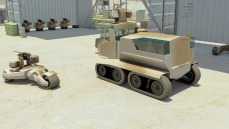
FARNBOROUGH, UK -- A vehicle which can `sweat` to improve stealth was among hundreds of ideas presented to the UK Ministry of Defence from a BAE Systems study designed to show them the future.
The Future Protected Vehicle programme aims to highlight both short and long-term technologies and concepts which can be used to boost the effectiveness of lightweight armoured vehicles.
The numbers give an idea of the scale of the programme: 567 technologies and 244 vehicle concepts were investigated following engagement with 35 organisations.
From this array of concepts, the team subsequently developed seven concept vehicles, each highlighting technologies which could support a particular specialisation. No fewer than 47 of the technologies were highlighted as being suitable for immediate pursuit.
The BAE Systems team made a point of gathering ideas from as wide a spectrum as possible, including academe and industry. A series of "Dragons' Den*" style panels identified ideas for further study, funded out of the £2 million DSTL (Defence Science and Technology Laboratory) contract.
The team even engaged Shanklea Primary School near Newcastle where pupils were invited to participate in design classes to stimulate interest in engineering as a career.
The study was managed for the MoD by DSTL. Its land strategy lead John Hunt commented: "I was very impressed by the work. Not just by the outputs, but also the inclusivity with which the study was carried out and the robust systems engineering methodology underpinning it."
"The 'quick wins' element was particularly pleasing as support to current operations is vital," Hunt added.
Hisham Awad, who works on emerging technologies for BAE System's Vehicles business, commented: "BAE Systems has signalled intent for future armoured vehicles programmes by bidding and winning the research contracts that enable bright ideas to become new innovative and highly capable vehicles."
The team already has a contract extension to do further work and will bid for the next phase virtual prototyping work.
The seven concept vehicles were:
- Pointer: an agile robot which can take over dirty, dull or dangerous jobs, such as forward observation to support the dismounted soldier;
- Bearer: a modular platform which can carry a range of mission payloads, such as protected mobility, air defence and ambulance;
- Wraith: a low signature scout vehicle;
- Safeguard: an ultra-utility infantry carrier or command and control centre;
- Charger: a highly lethal and survivable reconfigurable attack vehicle;
- Raider: a remotely or autonomously controlled unmanned recce and skirmishing platform; and
- Atlas: a convoy system (retrofittable if necessary) which removes the driver from harm's way.
Ideas identified for exploitation include:
- Sweating vehicle could use water from a diesel or fuel cell propulsion system to reduce a vehicle's thermal signature by "sweating" it out through pores in the vehicle skin. That same water could also be reclaimed to enable soldiers to stay in the field for longer.
- eCamouflage will allow a vehicle to match its camouflage to its surroundings by using electronic ink - rather like a squid.
- Integrated biometrics will ease the workload on soldiers in complex crowd situation such as roadblocks and riots by running video surveillance through facial recognition and behaviour modelling software to spot potential troublemakers.
- Active protection will intercept incoming fire or disrupt targeting mechanisms while actuated spaced armour will allow a vehicle to deploy in "compact" mode before extending its armour to provide increased stand-off distance. A version of this is envisaged as employing electro-magnetic magnets to "float" above a vehicle to provide protection from aerial threats.
- Advanced oil filtration will remove water and tiny particles from engine oil to extend to the life of the engine and eliminate oil changes;
- Handheld target acquisition devices integrated into the vehicle architecture will improve flexibility and capability; and
- Thermo-electric power generation, which uses the temperature difference between the inside and outside of the exhaust pipe, offers better fuel efficiency, more electrical power and improved stealth.
*Dragons' Den is a BBC TV programme in which budding entrepreneurs bid for cash from venture capital "dragons" for their business ideas.
BAE Systems
17.12.2010